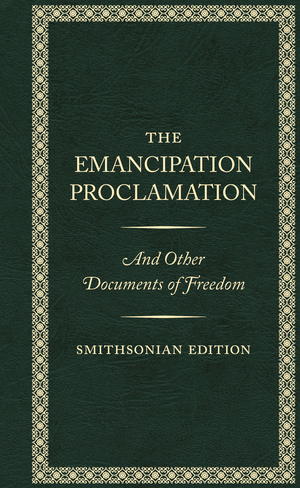A Long Story of Freedom Seeking
A Smithsonian curator’s insight into the Emancipation Proclamation
:focal(495x693:496x694)/https://tf-cmsv2-smithsonianmag-media.s3.amazonaws.com/filer_public/49/03/4903c51a-5b7e-4651-a630-cd5eaf1e687f/a_proclamation.jpg)
On September 22, 1862, Abraham Lincoln issued the preliminary Emancipation Proclamation. Under his wartime authority as commander-in-chief, he ordered that as of January 1, 1863, enslaved individuals in all areas still in rebellion against the United States “henceforward shall be free.” On New Years’ Day, the day the Emancipation Proclamation was signed, cannon shots fired, church bells rang, and speakers orated at public observances throughout the North and in Union-held areas of the South. January 1, formerly known among the enslaved as “Heartbreak Day” for the large slave auctions often held, would be known henceforth as a day of deliverance and jubilee.
In Union-held Beaufort, South Carolina, Colonel Thomas Wentworth Higginson presided over a ceremony where the Proclamation was read publicly. After the reading, Higginson related, he waved the flag and there arose from among the freed slaves on hand an “elderly male voice, into which two women’s voices instantly blended, singing . . . ‘My Country, ’tis of thee, Sweet land of liberty.’. . . I never saw anything so electric; it made all other words cheap . . . the life of the whole day was in those unknown people’s song.”
The Proclamation was carried and read as portions of the South were occupied. Every advance of the Union army thus became a liberating step, providing for the nation the possibility of what Abraham Lincoln in his Gettysburg address called “a new birth of freedom.” As Frederick Douglass, one of the individuals who had the greatest influence on Lincoln in issuing the document declared, “We are all liberated by this Proclamation. . . . The white man is liberated, the black man is liberated.”
Even though the Emancipation Proclamation was made effective in 1863, it could not be implemented in places still under Confederate control. As a result, in the westernmost Confederate state of Texas, nominal freedom came on June 19, 1865, when some two thousand Union troops arrived in Galveston Bay, Texas, at the end of the Civil War, and announced that enslaved Black people in the state were no longer in bondage, although most held in slavery had not waited to be freed. This day came to be known as “Juneteenth” by African Americans in Texas, heralding our country’s second Independence Day and now officially recognized as a national holiday. By the end of the war, millions of enslaved people, some with the assistance of the US Army and the federal government, had seized their own freedom.
The story of the Emancipation Proclamation, one of the most important documents of freedom in American history, and the wider story of emancipation of which it is a vital part, was never inevitable. The process through which the Proclamation was crafted reveals a deeper and wider story about the meaning of freedom in America and the paradox of liberty in a nation founded with slavery structured into the Constitution and a mainspring of its economic, social, and political life. It also provides a window into a long story of freedom seeking and making by African Americans that continues to have deep meaning today.
/https://tf-cmsv2-smithsonianmag-media.s3.amazonaws.com/filer_public/88/44/88448669-cbbe-4184-a1b4-cde50841c520/emancipation_proclamation_inkstand.jpg)
Transfer from Library of Congress
President Lincoln drafted the Emancipation Proclamation as a matter of military and diplomatic necessity but also because of his growing recognition of abolition as a matter of moral necessity and his ongoing struggle to embrace wider rights of African Americans within the nation—all of which continued up until his assassination. He hoped to undermine the Confederate war effort by declaring enslaved people free in only those ten rebellious states. Nonetheless, emancipation became a moral and social imperative. Long before the Proclamation was envisioned, Black abolitionists along with white allies had fostered a decades-long movement and political crisis that seized upon wartime conditions and led in 1862 to the emancipation acts in federal territories and the nation’s capital, Washington, DC. Enslaved African Americans who had sought freedom for generations further forced collective emancipation by fleeing to Union camps by the tens of thousands.
In the nation’s capital Lincoln himself witnessed African American freedom claims as he passed through tent cities built by fugitives from slavery.
While the Proclamation was limited and conservative by intent, its impact was revolutionary. The Civil War, which began as a war to preserve the Union, was transformed by the stroke of a pen into a war to end slavery, yoking the project of freedom for all to the very survival of the nation. Its repercussions meant more than just the end of slavery. It signaled the possibility of a second founding for America—one that included the potential for African Americans to find equality as full citizens in American society.
The Thirteenth Amendment, issued on December 6, 1865, completed what free and enslaved African Americans, abolitionists, and the Emancipation Proclamation had set in motion, formally abolishing slavery throughout the United States. The Fourteenth and Fifteenth Amendments provided equal protection of the law for all citizens, extended the vote to Black men, and banned racial discrimination in voting. They transformed the United States into the first interracial democracy in world history, albeit one that continued to be threatened by segregation, injustice, and racial violence.
The struggle to fulfill the promises of liberty, equality, and justice for all would continue for generations to come. In this struggle for fuller freedom, we find the roots of many movements for civil and human rights that exist today, demonstrating that the work of seeking equality and justice for all in the United States is unfinished and ongoing.
The Emancipation Proclamation, Smithsonian Edition is available from Smithsonian Books. Visit Smithsonian Books’ website to learn more about its publications and a full list of titles.
Excerpt from The Emancipation Proclamation, Smithsonian Edition, Introduction © 2022 by Smithsonian Institution

